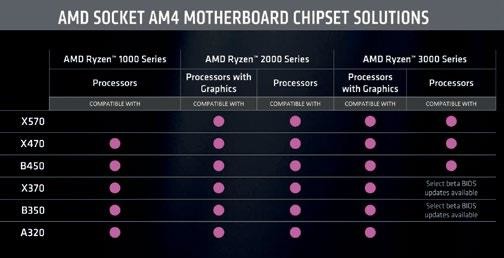Things to know if you’re looking to upgrade.


RYZEN 3000 USES THE NEW ZEN 2 MICROARCHITECTURE
The Ryzen 3000 processors are based on AMD’s new Zen 2 architecture, the successor to both Zen and Zen+. Much like the ‘tock’ in Intel’s now dead tick-tock model, Zen 2 represents a major overhaul of the CPU design. It’s taken a leaf from the book of AMD’s Epyc server CPUs, codenamed Rome, and features "chiplets” built on TSMC’s 7nm process. These contain CPU cores and are paired with a 14nm I/O die that provides direct connections to memory, which should alleviate concerns about latency that plagued the Zen and Zen+ chips.
Overall, AMD is claiming a 15 per cent improvement in IPC for Ryzen 3000, which is good news for both single-threaded and multi-threaded performance. In fact, AMD’s own numbers in Cinebench R20 puts the octa-core Ryzen 7 3800X, which has a base clock of 3.9GHz and boost clock of 4.5GHz, at 3 per cent ahead of the Core i79700K in single-threaded performance. This is quite impressive, especially considering that the Intel chip boosts to 4.9GHz, although it should be noted that Cinebench R20 is a floating point rendering test that AMD already does well on.
LOOK OUT FOR THE RYZEN 9 3900X AND RYZEN 7 3700X
The Ryzen 9 3900X comprises a brand new tier for Ryzen. As a 12-core/24thread chip, it’s inching into Threadripper territory and is the only Ryzen CPU to feature two chiplets in a 6+6 configuration (the others only have one chiplet). It has a base frequency of 3.8GHz and boost frequency of 4.6GHz, along with 64MB of L3 cache. Having said that, this new Ryzen 9 chip looks like it could be a very attractive option for those who want HEDT performance at a more mainstream price, given that it retails at US$499.
But the real mainstream champion might actually be the Ryzen 7 3700X. This is an 8-core/16-thread chip with a 3.6GHz base clock, 4.4GHz boost clock, and 32MB of L3 cache. However, what’s really impressive is its TDP, which stands at just 65W. It looks like it’s shaping up to be a really efficient chip, and it’s going to retail at just US$329.

PCIE 4.0 IS HERE
X570 is the first consumer motherboard chipset to feature PCIe 4.0 by default. It features double the bandwidth of PCIe 3.0, which means that a PCIe 3.0 x16 slot is equivalent to a PCIe 3.0 x8 slot. Fortunately, the PCIe standard maintains both backward and forward compatibility with older and newer specifications via both software and hardware, so you’ll still be able to use your PCIe 3.0 graphics cards on AMD X570 motherboards. However, these cards will still be limited to PCIe 3.0 speeds.
But while no consumer GPUs currently support PCIe 4.0, there is one other area that could benefit. Companies like Gigabyte and Corsair have already announced PCIe 4.0 SSDs, so storage will be one of the first areas to benefit from the shift to PCIe 4.0. To put things in perspective, the Aorus NVMe Gen4 SSD can reportedly hit up to 5,000MB/s read and 4,400MB/s write speeds. That amounts to 56 per cent better read performance and double the write speeds of the Samsung 970 EVO, already one of the fastest NVMe drives you can buy today.

X570 IS CURRENTLY YOUR ONLY WAY TO ENJOY PCIE 4.0
Despite initial rumors that it would be possible to enable PCIe 4.0 on older chipsets like X470, X370, and B450 – at least from the CPU – via a firmware update, AMD has snuffed out that idea. PCIe 4.0 will not be coming to older motherboards, and you'll need to get an X570 board or newer if you want the feature. Future 500-series chipsets will support it as well, so you won’t always be restricted to X570.
This is because there’s no guarantee that older motherboards will reliably support the more stringent signaling requirements of PCIe 4.0. AMD doesn’t want to pass this uncertainty on to consumers, which is why it’s opting to withhold support across the board for all older motherboards.

BACKWARD COMPATIBILITY ISN’T GUARANTEED
While AMD has committed to supporting the AM4 socket till 2020, which supposedly means full compatibility as long as both CPU and motherboard use the same socket, that's not entirely the case with this generation of products. Firstly, X570 will not support any first-generation Ryzen Summit Ridge or Raven Ridge chips, so you're out of luck if you own one of those. Furthermore, AMD is leaving support for Ryzen 3000 on X370 and B350 to the discretion of manufacturers, while A320 will not be getting any BIOS updates for the new chips at all. To put things simply, you're good if you have an X470 or B450 board, but you'd best check the support page for your specific 300-series motherboard to see if the Ryzen 3000-series is supported.
PICTURES AMD























